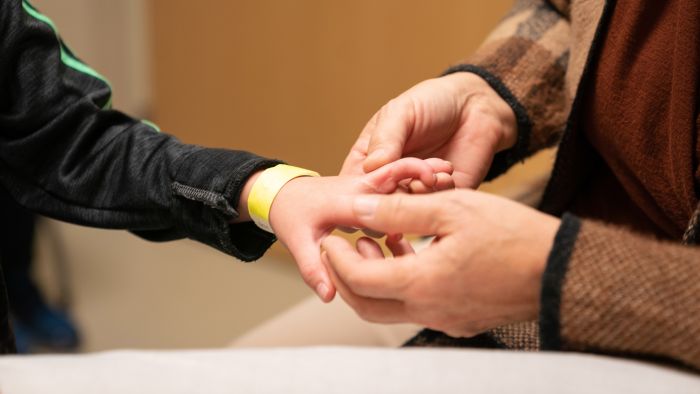Gillette Finds Strong Use Case for Skin Graft Substitute
Gillette Children’s hand surgeons Ann Van Heest, MD, and Deborah Bohn, MD, recently hosted the World Symposium on Congenital Malformations of the Hand and Upper Limb in Minneapolis. At this event, Dr. Van Heest presented their collective two-year study, Scar Formation Comparisons Following Syndactyly Release Surgery with Either Full Thickness Skin Graft Versus Hyaluronic Acid Skin Graft Substitute: a Randomized Within-Subject Controlled Trial.
The physicians looked at scar healing following syndactyly release surgery between traditional treatment, a full thickness skin graft (FTSG), and a skin graft substitute called hyaluronic acid (HA).
Syndactyly is one of the most common congenital hand conditions. It occurs when fingers do not separate as expected during fetal development. Syndactyly can vary in severity, and can involve a skin fusion or bone fusion. When surgically separating a child’s fused fingers, the gold standard has been to use skin grafts harvested from the groin to cover any exposed areas of the fingers and hand.
According to Dr. Van Heest: “Although good results for the use of HA in syndactyly surgery have been reported in European literature, Dr. Bohn and I wanted to take the opportunity to compare the effectiveness, wound healing, scar formation, and potential complications of both techniques before offering it as part of our routine practice at Gillette.“
During the syndactyly release surgeries included in the study, each web on the child’s hand(s) that required surgery had an FTSG placed on one open area and HA on the other open area. The open area where the skin graft is placed was randomly assigned using computer software.
After surgery, Dr. Van Heest monitored the effectiveness, healing, scar appearance, and potential complications of both HA and the current FTSG technique. The doctor found that the HA was noninferior in all qualities except that it had a slightly higher rate of infection.
Hyalomatrix Offers Patient-Centered Benefits
Though scar appearance was similar, there are several presumed benefits of using HA over the current gold standard of FTSG.
1. Limited exposure to anesthesia
Utilization of HA would eliminate the need to harvest the skin graft from another region of the child’s body, thus dramatically shortening the length of surgery and the child’s duration of anesthesia. Prolonged anesthesia and brain development is always a significant concern for pediatric surgeons.
2. Avoidance of scars associated with obtaining skin grafts
HA eliminates the need to obtain a skin graft from a different region of the child’s body. Therefore, the risks associated with further infection or prolonged healing following skin graft are avoided.
3. Reduced costs compared to traditional skin grafts
HA is inexpensive and comes at a moderate cost reduction when compared to using FTSG. A single sheet of the material can cover both exposed areas of a young child’s separated fingers.
Although further research is warranted to look at additional variables such as graft healing over time, variation in skin types, and the suture or dressing used, these results can already guide clinicians and parents in making informed decisions regarding the use of HA in syndactyly release surgery.
Dr. Bohn says: “HA has the potential to improve patient outcomes, reduce costs, and minimize the scars associated with syndactyly release surgery. To me, this is an exciting development that could update the current standard of FTSG.”
Gillette Hosts Course on Evaluation and Treatment of Upper Extremity in Cerebral Palsy
As part of a day-long course at the World Symposium on Congenital Malformations of the Hand and Upper Limb, Gillette providers Ann Van Heest, MD, and Deborah Bohn, MD, discussed nuances of evaluation and treatment of the upper limb in children with cerebral palsy. They shared Gillette’s comprehensive system used to pre-operatively evaluate children considering upper extremity surgical treatment, including use of simultaneous EMG with video monitoring in the James R. Gage Gait and Motion Lab.
Gillette Children's is a care destination for children with rare congenital conditions that impact the hand and arm. To learn more about pediatric upper extremity concerns, call 651-325-2200.
Get Partners in Care Stories in your inbox!
Subscribe to Partners in Care Journal, a newsletter for healthcare providers and community health professionals.
Subscribe Today Home Page
Home Page



